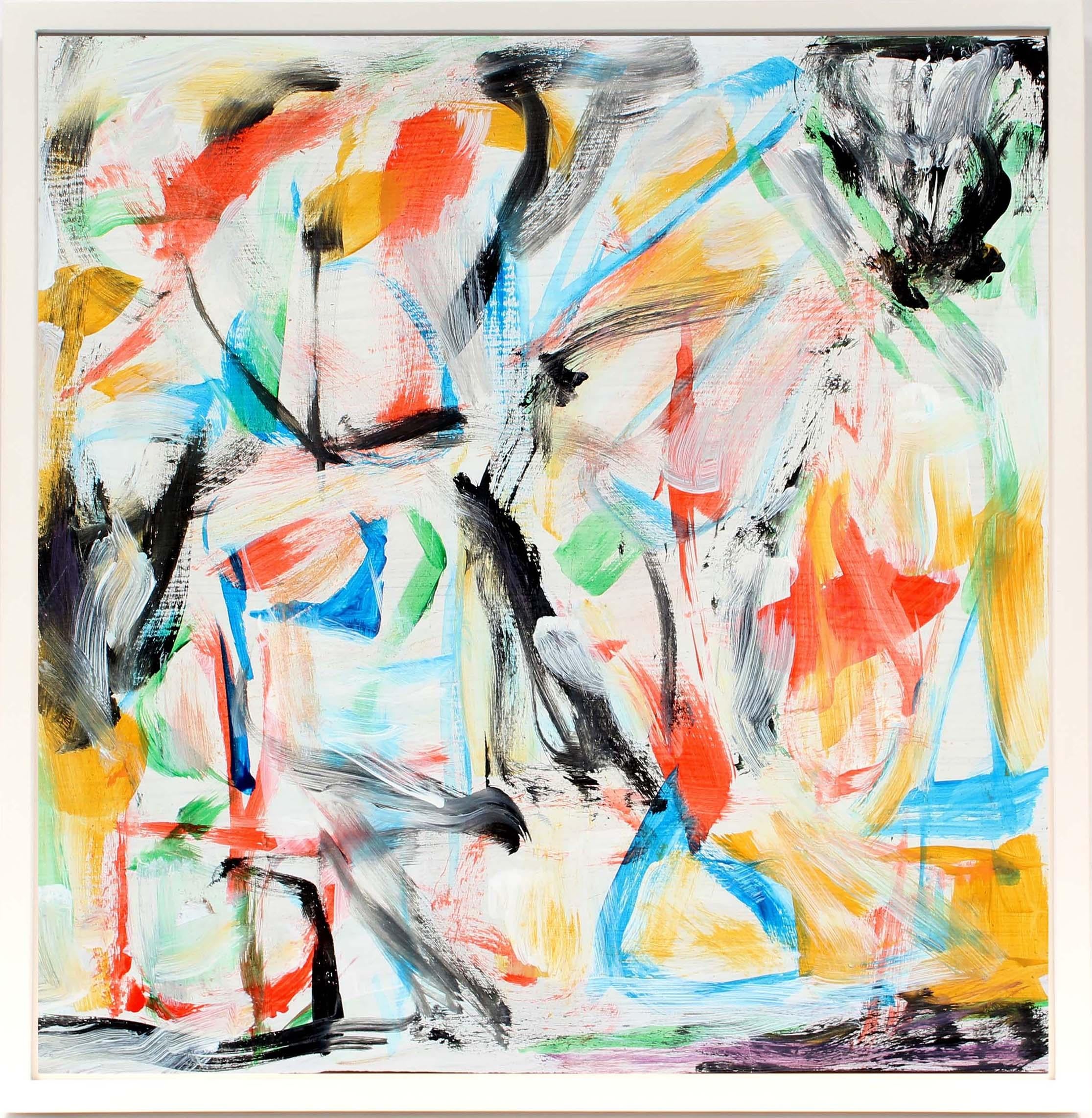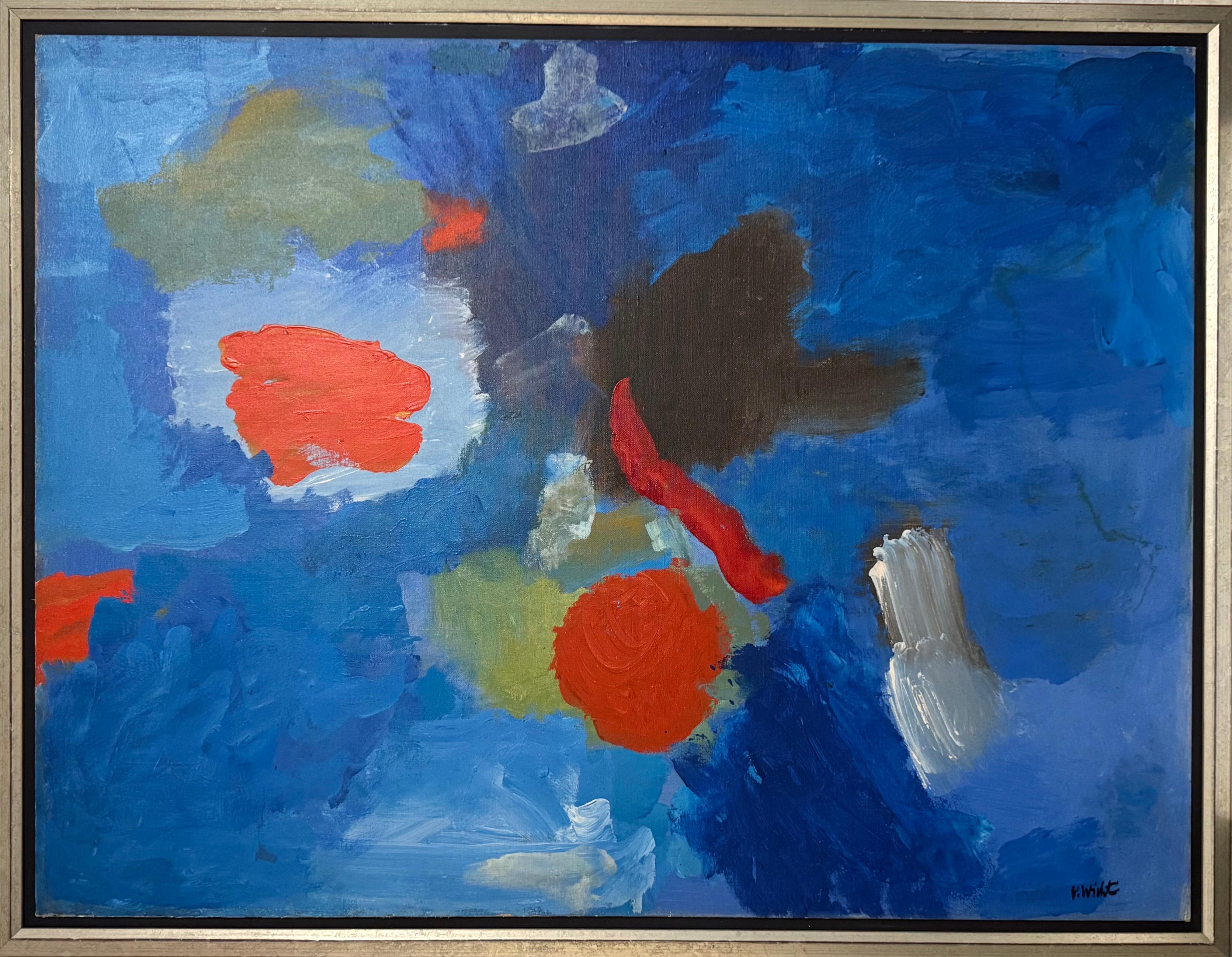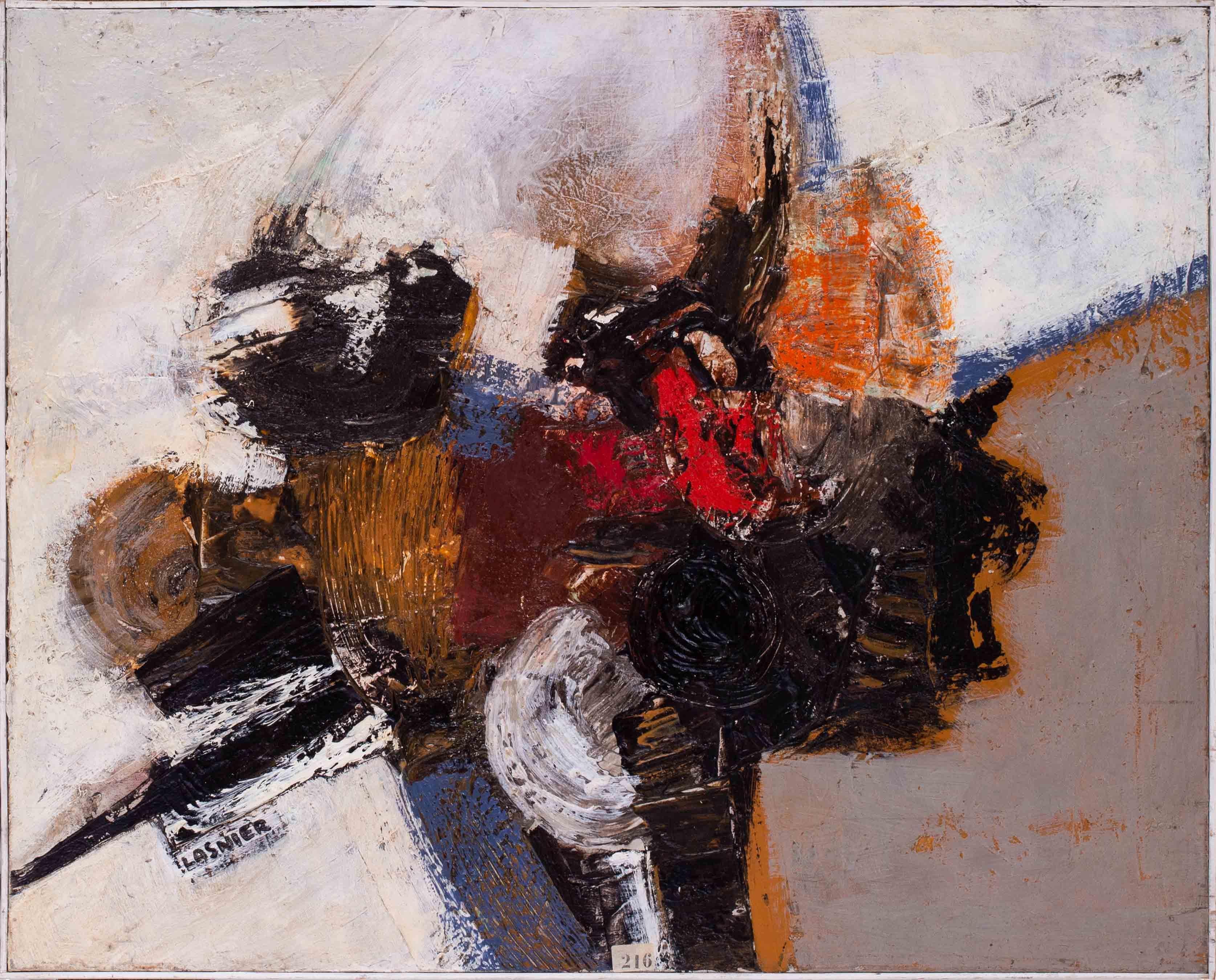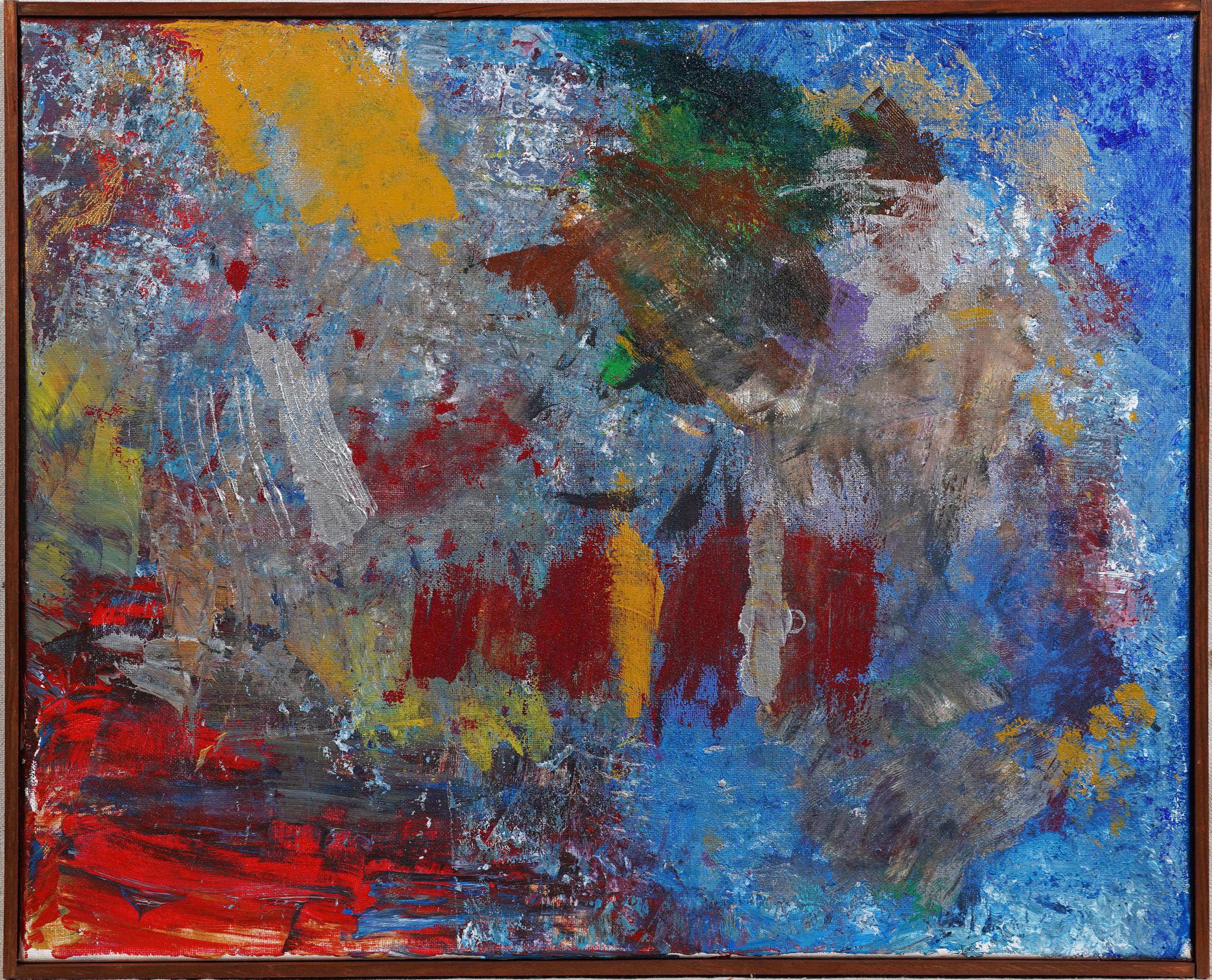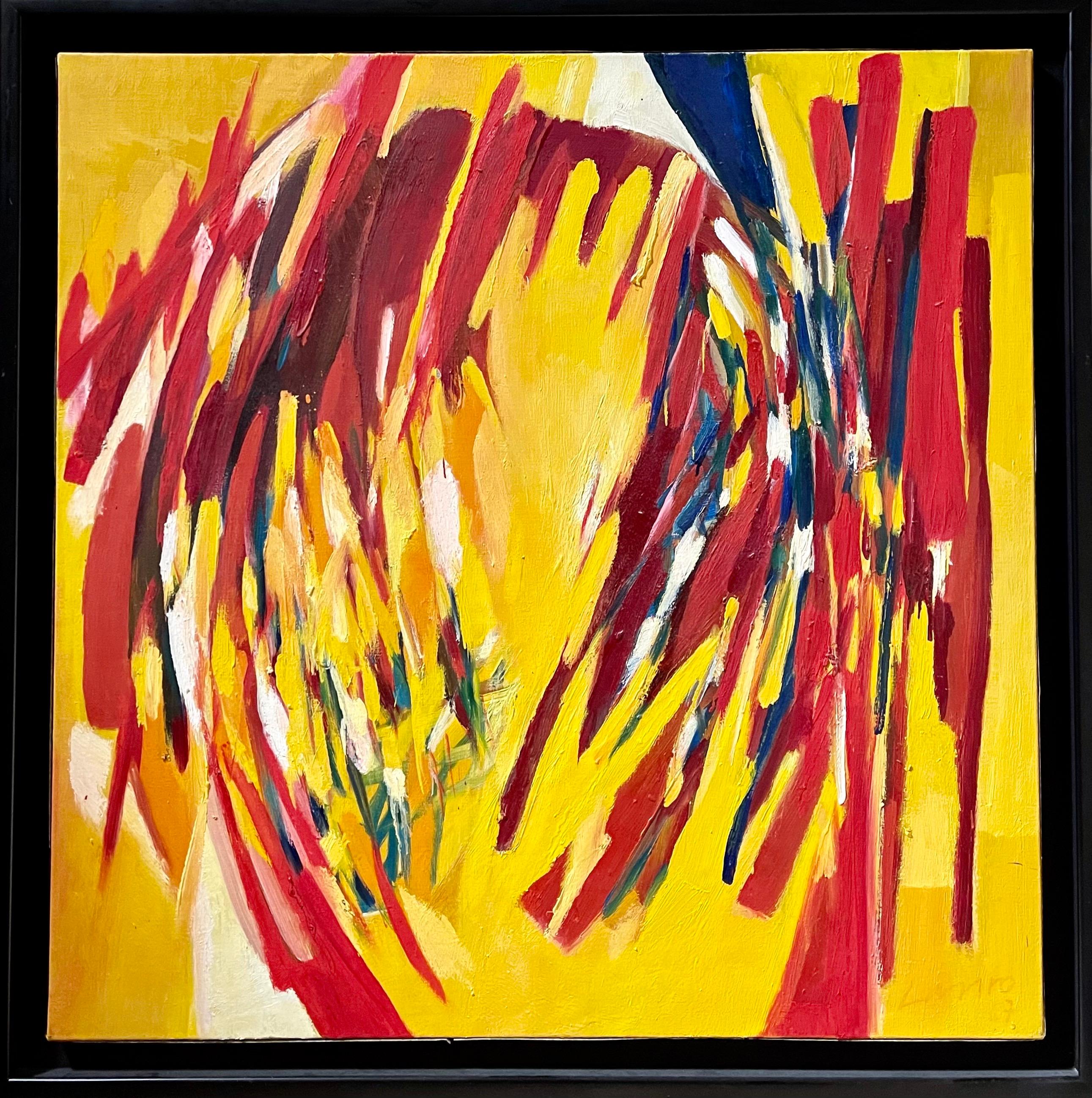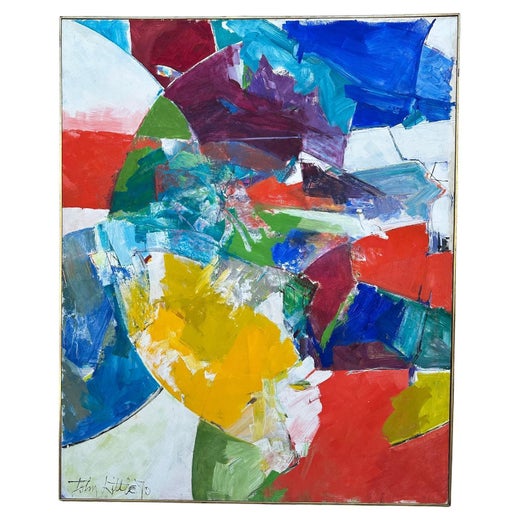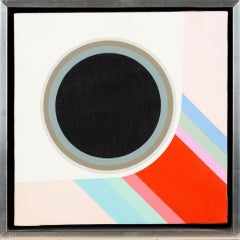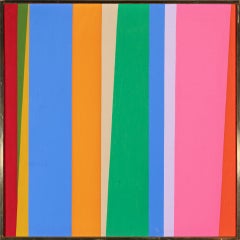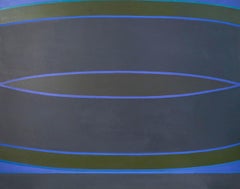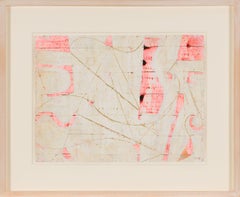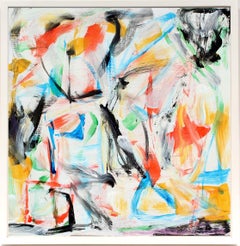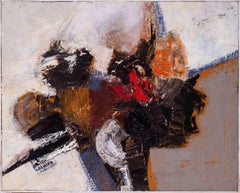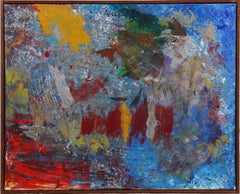Items Similar to WHIGMARLEERIE Canadian Acrylic Mid-20th Century Abstract Canvas Painting
Video Loading
Want more images or videos?
Request additional images or videos from the seller
1 of 10
John LittleWHIGMARLEERIE Canadian Acrylic Mid-20th Century Abstract Canvas Painting1966
1966
$16,000
£12,082.56
€13,833.42
CA$22,596.18
A$24,669.62
CHF 12,933.27
MX$299,622.06
NOK 161,515.53
SEK 152,513.73
DKK 103,251.74
About the Item
John Little
1907 – active in New York - 1984
Whigmarleerie
1966
Oil on canvas
33 x 27 inches (84 x 69 cm)
Framed dimensions: 35 x 29 inches (89 x 73.6 cm)
Signed, titled and dated verso: Whigmaleerie 1966 John Little
Provenance:
Private Collection, NJ
In the late 1940s John Little moved to East Hampton, where he became involved with the Abstract Expressionist movement; his teacher was Hans Hofmann . Little ran in the same circles as Jackson Pollock, Lee Krasner, and the other artists who were the leading innovators in the New York School.
John Little left his home in Alabama at the age of 14 to become an artist, and moved to Buffalo, NY in 1923. After spending a year working as a stevedore on the docks to save money, he enrolled at the Buffalo Fine Arts Academy and developed an interest in singing. In 1927 he moved to New York City where he continued his vocal work and studied operatic literature. He also became involved in textile design, opening his own store in 1920, called John Little Studios. He ran the store until 1950.
In 1933 John Little resumed his painting studies at the Art Students League in New York under the guidance of George Grosz (1893-1959). The following year he made his first visit to East Hampton which he would eventually call home. Later in the decade, he traveled to Paris where he became familiar with European modernism. On his return to America, he taught textile design at the Pratt Institute in Brooklyn. He hired Josephine Watkins to work for him; she later became his wife. Little's textile store and teaching job gave him a financial security that was rare during the Depression, and he never found it necessary to find employment with the Works Progress Administration. At the end of the decade, John Little studied with Hans Hofmann (1880-1966) in New York and Provincetown. Little was greatly influenced by Hofmann, particularly by his views on color theory.
In 1942 John Little joined the Navy as an aerial photographer. In the late 1940s he purchased a rundown house on Three Mile Harbor Road in East Hampton, near where he had been frequently visiting Jackson Pollock and Lee Krasner. In 1948 he had his first one-man show in New York at the Betty Parsons Gallery, where he would continue to exhibit frequently in the years ahead. He closed his textile business in 1950 and become a permanent resident of East Hampton, although he still maintained a studio in the city. In 1957 Little made an important contribution to the East Hampton scene when he opened the first commercial art gallery, the Signa Gallery, with his artist friends Alfonso Ossorio (1916-1990) and Elizabeth Parker (1893-1975).
John Little continued to exhibit widely, travel and painted until he died in 1984. Examples of his work can be found in many important private and public collections including the Ball State University Museum of Art, Muncie, Indiana; Bruce Museum, Greenwich, Connecticut; Dillard University, New Orleans; Fine Arts Museums of San Francisco, California; Guild Hall Museum, East Hampton; Metropolitan Museum of Art, New York; and the University Art Museum, Berkeley, California.
- Creator:John Little (1907-1984, American)
- Creation Year:1966
- Dimensions:Height: 35 in (88.9 cm)Width: 29 in (73.66 cm)
- Medium:
- Movement & Style:
- Period:
- Condition:
- Gallery Location:New York, NY
- Reference Number:1stDibs: LU2733214545092
John Little
Born in Alabama, John Little attended the Buffalo (NY) Fine Arts Academy as a teenager, until 1927. Soon after, he moved to New York where he began operatic vocal training and opened what would become a very successful textile business designing fabric and wallpaper. In 1933, he enrolled at the Art Students League under the tutelage of George Grosz. Little’s early work consisted predominantly of landscapes, until 1937, when he began studying under Hans Hofmann and his work naturally shifted toward abstraction. During his time with Hofmann, he with artists such as Lee Krasner, George McNeil, Gerome Kamrowski, Giorgio Cavallon, and Perle Fine. Little entered the the service in 1942 as an aerial photographer for the Navy. Returning to New York after the war and with nowhere to stay, he reconnected with Hofmann and moved into his 8th Street studio, alongside his friend Lee Krasner and her husband Jackson Pollock. In 1946, Little earned his first solo exhibition at the California Palace of the Legion of Honor in San Francisco, with a subsequent solo exhibition at Betty Parsons Gallery in New York two years later. In the early 1950s, Little abandoned the flat, linear style in favor of a new aesthetic consisting of the thick, gestural buildup of paint. This stylistic change was concurrent with his move to East Hampton In 1951. This enabled him to continue a close friendship with Krasner and Pollock, who had already left the city in favor of the more rural area around East Hampton. Little and Pollock had a joint exhibition in 1955 at Guild Hall, one year before Pollock’s tragic death. John Little exhibited extensively during his career, with solo shows at Betty Parsons Gallery (1948), Bertha Schaefer Gallery (1957, 1958), Worth Ryder Gallery (1963), A.M. Sachs Gallery (1971), and a retrospective at the Guild Hall Museum (1982). His work can be found in many private, institutional, and corporate collections around the world, including the Metropolitan Museum of Art, Guild Hall Museum, Ball State University Museum of Art, and Galerie Beyeler.
About the Seller
No Reviews Yet
Recognized Seller
These prestigious sellers are industry leaders and represent the highest echelon for item quality and design.
Established in 1992
1stDibs seller since 2024
Typical response time: 11 hours
- ShippingRetrieving quote...Shipping from: New York, NY
- Return Policy
Authenticity Guarantee
In the unlikely event there’s an issue with an item’s authenticity, contact us within 1 year for a full refund. DetailsMoney-Back Guarantee
If your item is not as described, is damaged in transit, or does not arrive, contact us within 7 days for a full refund. Details24-Hour Cancellation
You have a 24-hour grace period in which to reconsider your purchase, with no questions asked.Vetted Professional Sellers
Our world-class sellers must adhere to strict standards for service and quality, maintaining the integrity of our listings.Price-Match Guarantee
If you find that a seller listed the same item for a lower price elsewhere, we’ll match it.Trusted Global Delivery
Our best-in-class carrier network provides specialized shipping options worldwide, including custom delivery.More From This Seller
View AllUntitled Italian abstract 20th century acrylic on canvas
By Eugenio Carmi
Located in New York, NY
Provenance:
Court Gallery, Copenhagen, Denmark
Private Collection, Baltimore
Private Collection by descent
This painting has a Certificate of Authenticity from the Eugenio Carmi Arc...
Category
1980s Abstract Abstract Paintings
Materials
Canvas, Acrylic
GRADUS AD PARNASSUM Abstract acrylic painting 1970 bright colorful lines signed
By Jay Rosenblum
Located in New York, NY
Jay Rosenblum was a native of the Bronx who studied at Bard College and the Cranbrook Academy of Fine Arts in Bloomfield Hills, Michigan. He also passionately studied music and was a...
Category
1970s Abstract Expressionist Paintings
Materials
Canvas, Acrylic
BLUE EDGE 20th century oil painting Abstract 60s color field by Michael Loew
By Michael Loew
Located in New York, NY
This painting is sold with a Certificate of Authenticity from the Estate of Michael Loew.
In the late 1920s Michael Loew was enrolled at the Art Student’s League and later was in France where he studied with Fernand Leger. Loew was close and longtime friends with Wilem de Kooning who influenced his work. After Pearl Harbor, Loew joined the Navy...
Category
1960s Color-Field Paintings
Materials
Canvas, Oil
PIETRASANTA PAINTING, late 20th century American gouache and ink
By Caio Fonseca
Located in New York, NY
Caio Fonseca
1959 active New York City
Pietrasanta Painting (P.95.122)
1995
Goauche and ink on paper
12 x 16 inches (30.5 x 40.6 cm)
Framed dimensions: 18 x 22 inches (45.7 x 56 c...
Category
1990s Abstract Paintings
Materials
Ink, Gouache
UNTITLED 1977, Paper Collage, 29" x 23" framed orange, green, blue and black
By Emerson Woelffer
Located in New York, NY
Once dubbed “the Grandfather of L.A. Modernism,” the Chicago-born Emerson Seville Woelffer was active as an innovative painter, collagist, and educator throughout his long and prolif...
Category
1970s Abstract Expressionist Mixed Media
Materials
Mixed Media
"Untitled" 20th century on paper signed and dated drawing
By Gene Davis
Located in New York, NY
Gene Davis
1920 – active in Washington DC - 1985
Untitled
1981
Colored felt tip on paper
17 ¾ x 12 ½ inches (49 x 32 cm)
Framed dimensions: 24 x 14 inches (61x 35.5 cm)
Signed and ...
Category
1980s Abstract Expressionist Abstract Drawings and Watercolors
Materials
Paper, Felt Pen
You May Also Like
Abstract Expressionist Painting American 1960's Mid Century New York Colorful
Located in Buffalo, NY
Mid Century Modern, American Abstract Expressionist Painting on Masonite.
This wonderful work in exciting colors is housed in a contemporary white wood frame presentation..
The art...
Category
1960s Abstract Expressionist Abstract Paintings
Materials
Masonite, Acrylic
$340 Sale Price
20% Off
Large Abstract Expressionist Oil Painting on Canvas John Von Wicht WPA Artist
Located in Surfside, FL
John von Wicht (German American, 1888-1970)
"On Blue"
1964
Oil and acrylic on canvas
Hand signed lower right "V. Wicht",
Hand signed, titled, and dated on the stretcher "1964-66"
D...
Category
1960s Abstract Expressionist Abstract Paintings
Materials
Oil, Canvas, Acrylic
Mid Century French abstract oil on canvas by Jean Maurice Lasnier
Located in Petworth, West Sussex
Jean Maurice Lasnier (French, 1922 – 2006)
Tempete Industrielle
Signed ‘LASNIER’ (lower left)
Oil on canvas
25.3/4 x 32 in. (65.4 x 81cm.)
Provena...
Category
20th Century Abstract Expressionist Abstract Paintings
Materials
Canvas, Oil
Vintage American Modernist Abstract Expressionist Framed Oil Painting
Located in Buffalo, NY
Antique American modernist abstract oil painting. Oil on canvas. Framed.
Category
1970s Abstract Abstract Paintings
Materials
Canvas, Oil
$396 Sale Price
20% Off
Lonistum 1961 - Canadian British Abstract art oil painting
By William John Bertram Newcombe
Located in Hagley, England
An original large abstract oil on canvas by British Canadian artist William John Bertram Newcombe. This stunning abstract expressionist oil in blues and greys is a bold, adventurous ...
Category
1960s Abstract Abstract Paintings
Materials
Mixed Media, Oil
$3,747 Sale Price
20% Off
1960's Large Colorful Abstract Expressionist Swiss Oil Painting Robert Lauro
Located in Surfside, FL
Oil Painting on canvas
Hand signed to lower right Lauro.
Provenance: Eleonore Austerer Gallery, San Francisco, CA
Work Size: 39.5 x 39.5 in. framed 44 X 44 inches.
Roberto Lauro is a British-Swiss Post War & Contemporary artist who was born in 1932.
Roberto Lauro was born in 1932 in Gorey Harbor on the island of Jersey (Great Britain) the son of a Swiss mother, Rosa Ramseier, from Oberdiessbach / Emmental, Switzerland, and and Italian father Innocenzo Roberto Lauro, born in Mondovi, Italy. In 1941 he moved to Switzerland with his mother. 1949-1953 he lived in Gunten (Switzerland) where he did an Apprenticeship as a lithograph and offset printer and graphic designer in Thun. There he was introduced to the color theory of Johannes Itten by Hermann Oberli at the Bern School of Applied Arts. From 1953 to 1955 he worked as a fine art printer in Norway where he was influenced by the color theory of Edvard Munch. These works bears the influence of Russian artist Andre Lanskoy, Tachisme and the Cobra artists Karel Appel, Constant, Corneille, Christian Dotremont, Asger Jorn, and Joseph Noiret.
In 1955-1956 he worked as an offset printer in Amsterdam (Netherlands). Visit to the Instituut voor Kunstnijverheidsonderwijs. In 1957 he returned to Gunten, Switzerland. Where he started working in printmaking and and oil painting. He resumed his studies at the Bern School of Applied Arts. He was greatly impacted and influenced by abstract art on the occasion of a large Paul KIee exhibition. In 1958 he moved to Zurich where he worked part-time work as an offset copyist; fulfilling graphic orders for advertising agencies. In 1962 he took his final examination as graphic designer at the Zurich School of Applied Arts. In 1980 he begins his development of three-dimensional picture objects, Sculpture, detachment from the canvas, using metal as a support and play space for light and color. By 1981 he has turned full time to fine art. He spends the next years growing and developing his considerable talent. Inspired by classical music, the rhythm, mood and lightness of which form the basis for the large swings and loops of his colorfully lacquered metal and blown glass sculptures. These are "pensieri", thought sketches that capture the emotions in countless versions. There is something dance-like about his rotating sculptures. Everything becomes music and the rhythm of colors. In 1988, after exhibitions in Europe, he has his first exhibitions in Atlanta and San Francisco (USA), In 1989 he does his first glass and metal sculptures at the Roberto Niederer glassworks, Hergiswil (Switzerland). In 1992 has a retrospective exhibition in the Tan Gallery, Zurich, and the Eleonore Austerer Gallery, San Francisco. They Publish a catalogue raisonne, Eine Retrospektive, covering a 45 year career. In 1993 he creates A Retrospective, a unique sculpture in a table top form that contains his catalogue raisonne and an original lithograph.
1993–1995 he begins work on a number of large scale public outdoor commissions, including Light Columns for a Bank building, and a commission of a sculpture-fountain in Oetwil am See. In 2001 he creates a wall sculpture entitled "Color Poems of the Yearly Cycle. A linen bound book enclosed in a unique plexi display with a one - of a - kind metal and glass sculpture,containing 12 linocuts each printed in colors and signed.
Roberto Lauro's sculptural work work is spontaneous and loaded with energy. The furrows, rifts, cracks and scars in the metal allow light to enter; it is then reflected back by the glass. His work is a clear statement of our times, uniting the intellect and the heart in search of the spiritual. Like the interplay of light and shadow, his sculpture combines fragile, transparent glass with solid, heavy iron. These colorful and luminous sculptures convey a powerful presence and emit vibrant positive energy. With their jagged exteriors and translucent cores, the spectacular sculptures created by the synergy of metal and glass are powerful - yet fragile. Lauro has created and mastered his own idiom and proven that through the artist sheer will and vision, seemingly incompatible materials such as iron and glass can indeed be combined. In 2004 he has an anniversary exhibition Light and Color, Love of Life on the island of birth, Jersey. Ceramic works (raku with glass inclusions). Roberto Lauro's works have been shown in numerous exhibitions in Europe and the USA around the world, and he has also realized projects such as "KUNST AM BAU" in public spaces and for industry. He lives and works in Switzerland.
Select Exhibitions
Eleonore Austerer Gallery, Palm Desert
ART IN THE FRAME FOUNDATION: The Harbour Gallery, Isle of Jersey
Galerie fur Gegenwartskunst,, Bonstetten, Switzerland
Galerie Annamarie Anderson, Zurich, Switzerland
“Color and Light,” Austerer-Crider Gallery, Palm Springs, CA, USA
“Color and Light: the art of Roberto Lauro,” Eleonore Austerer Gallery, San Francisco, CA, USA
“Flower Power,” with Ed Baynard, Roberto Azank, Siegward Sprotte, and Daniel Phil...
Category
1960s Abstract Expressionist Abstract Paintings
Materials
Canvas, Oil
More Ways To Browse
Lee Krasner
Canadian Art 20th Century
Dior 1984
Lee Jackson
1930 Modern Art Paintings
Autumn Landscape Painting
Art In Ornate Gold Frame
Landscape Flowers Painting
19th Century English Paintings
Oil Paintings Of Flowers On Panel
Boat Frame
Pink Figurative Painting
Window Frames Used
Male Paintings
Horse Oil Painting
Horse Oil Paintings
Impressionist Red
Large Italy Landscape Oil Paintings
